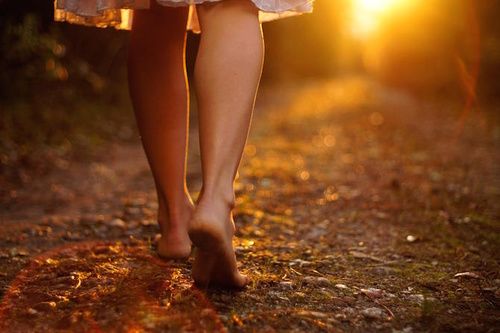Feet, ailments and all remedies
The feet are the part of us that speaks to the whole body, being sprayed with reflex points . Through the roll of the foot we push ourselves further, we manage to move. Warming the foot and ankle is essential before moving and massaging them should be a ritual . Let’s take a closer look at the feet, the therapies to treat them, the disciplines that improve their functionality and general state.
> Anatomical description of the feet
> Natural treatments and therapies
> Yoga for the feet
> Traditional Chinese Medicine
> Other disciplines for foot health
> Curiosities about the feet

Anatomical description of the feet
Forefoot, midfoot, hindfoot. On all these parts are distributed 26 bones that support all the loads. Thanks to the feet we have assumed an upright structure and vertical posture.
The forefoot accommodates the bones of the phalanges and metatarsals; the midfoot the cuboid bone, the three cuneiforms and the tarsal scaphoid, while the hindfoot the talus bone (80% covered with cartilage) and the calcaneus. Filled with nerve trunks and intrinsic and extrinsic musculature, the foot is an engineering miracle of nature, a gift that man can dispose of to move in space.
Pathologies that can affect the foot are hallux valgus , hallux rigidus, various deformities of the toes, Morton’s neuroma (chronic irritation of the interdigital nerves of the feet), plantar fasciitis, heel spurs, sprains.
Natural treatments and therapies
If the problem is the bad smell of the feet, it can act on the food plan by eliminating white flours and yeasts a little (the cause in foot reflexology is associated with dysbiosis). Pathologies such as potyroidism and diabetes also affect the general odor of the foot and the well-being of all the lower limbs. When behind the bad smell there is no diagnosis of a pathology, you can act with home remedies such as foot baths based on sodium bicarbonate, vinegar, black tea.
Even a sage -based decoction is useful for bad smells, the same goes for parsley. Salt can also be added to the foot bath. Another very useful decoction is the one to be made with a piece of ginger .
When the problem is swelling in the feet it is better to eliminate dry and salt-rich foods, to resort to smoothies with foods rich in potassium (without milk and at most with the addition of ginger). Yes to oilseeds which contain excellent vegetable oils (almonds, sunflower seeds, walnuts, pumpkin seeds).
In case the problem was that of corns and calluses , essential oils of lavender or geranium can be used. You can apply them after the foot bath. Even the foot bath based on chamomile is a classic grandmother’s remedy, infallible. Salt is also highly healing. Put two tablespoons of coarse salt in the hot water for the foot bath and leave them immersed for about twenty minutes. Whole sea salt or Epsom salts can also be used .
Statistics from the American Podiatric Medical Association show that about 72% of Americans suffer from foot problems throughout their lives (such as plantar fasciitis, misalignment, foot ulcers, flat feet, foot pain, and pinching of the nerves).
Walking, why, how and where

Yoga for the feet
Many yoga positions such as Tadasana (Mountain Pose) allow the practitioner to become familiar with what it means to “stand”, in a profound sense, to stand on one’s feet, to develop grounding.
The exploration of balance in standing positions involves breathing. In general, practicing yoga is a great way to “awaken” the motor intelligence of the feet, work well on all points and return to understand how essential it is to enhance our support.
Traditional Chinese Medicine
The feet in Chinese Medicine represent our relationship with the outside world , they are a tangible mirror of our relationship with others. The feet are crossed by energy meridians and there is a specific diagnosis path which is based on the nail and morphological semeiotics of the foot.
For example, the liver meridian starts from the outer nail margin of the big toe nail of both feet and this determines that half of the big toe nail represents liver function. The gallbladder meridian ends at the outer nail border of the fourth toe of both feet. The reflex area of the gallbladder is located at the head of the fourth metatarsal of the right foot. The reflex area of the liver is located all around the head of the fourth metatarsal.
Other disciplines for foot health
Foot reflexology is a technique by which the energy balance of the body is re-established, using a particular type of massage which, through the stimulation and compression of specific reflex points on the feet , energetically related to organs and systems, allows you to exercise preventive action and intervention on any imbalances in the organism.
The onset of foot reflexology is traced back to ancient civilizations, especially oriental ones. However, various types of documents indicate that this technique was also practiced by the pre-Columbian civilizations and by the Red Indians. The representation of a fetus in the foot is present in a 6,000-year-old graffiti discovered in Valcamonica.
The discipline develops through the studies of I van P. Pavlov. At the beginning of the twentieth century, thanks to an American otolaryngologist, William Fitzgerald , some concepts in the field of foot reflexology began to be codified. The physiotherapist Eunice Ingham , today considered the true founder of modern reflexotherapy , based on the exploitation of a detailed map of the reflex zones that can be localized on the human foot, develops the master’s concepts .
Curiosities about the feet
- The number of bones of the feet is the same as that of the hands.
- The recipe for a good homemade foot scrub is simple: brown sugar and integral sea salts; they are crushed and mixed with a few drops of almond oil.



























+ There are no comments
Add yours